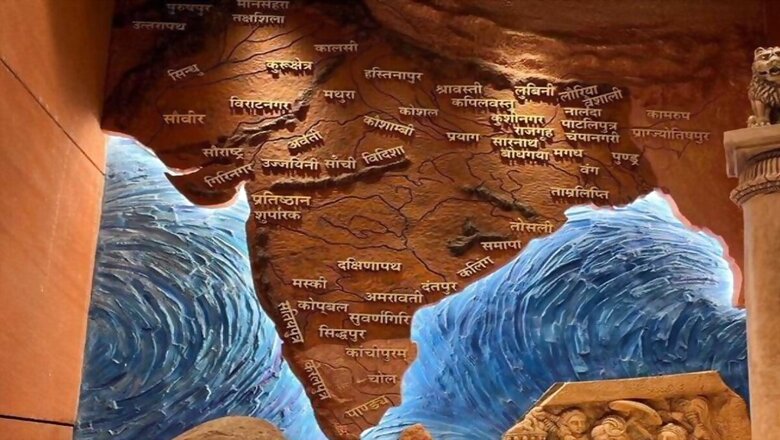
views
The message of the mural of Akhand Bharat in the new Parliament building would not be missed by anyone who tries to fathom how the mind of Prime Minister Narendra Modi works. It has a message both in the national and international context. India is sure to focus on maintaining its territorial integrity and expanding its cultural influence. And this is in line with the thought process of the new generation that wants to prosper forgetting conflict and giving peace a chance. The military strength of India is not to browbeat others but to secure our borders and allow citizens to grow in an atmosphere of peace. Thus, the new Parliament building showcases young India’s aspiration to be more meaningful as a matured democracy. The much talked about ‘Sengol’ is the symbol of righteousness and justice and a reminder to lawmakers that justice must be delivered to the last man on the street.
Chanakya said that we must have the strength to earn the respect of others. He is the one who built the mighty Magadhan Empire and tried to unite India to fight the Greeks. Those who are weak become victims of the predatory design of territory-hungry neighbours. The physical boundary loses sanctity due to the political aspirations of people for more land and power.
No country knows this more than India which witnessed its body being mutilated due to designs of the British Empire. The Empire was built on the military prowess of Indian soldiers but it never worked for the unification or unity of the country. Our learned leaders of the independence movement guided by the Western camouflage of liberalism and modern values refused to see their design. The need for a strong military was ignored under the false assumption that wars would not be needed in the new global order. China’s war on India in 1962 demolished this myth.
Before the British started increasing their footprint in India, Akhand Bharat comprised many more countries. If we go back to 1857, the first war of India’s independence when soldiers revolted against the British, Akhand Bharat geographically comprised territories of Afghanistan, Bhutan, Sri Lanka, Pakistan, Myanmar (former Burma), Bangladesh and Tibet. The 1857 war had broken the confidence of the British Empire and had laid the foundation for its final exit from India in 1947. The British started dividing the larger India into smaller countries. Afghanistan was separated in 1876, Bhutan in 1906, Sri Lanka in 1935 and Pakistan in 1947, from which Bangladesh was created in 1971. Tibet was also a part of India. Thus, these territories were once parts of a political setup of Akhand Bharat and that was not long time ago.
Culturally, Nepal continued to be identified with India, being so closely intertwined with Hindu culture and civilisation. Countries of Southeast Asia such as Malaysia, Indonesia, Thailand, Philippines, Vietnam and Cambodia were part of the larger version of India (Aryavata) as reflected in Ramayana and Mahabharata.
In any Hindu religious ceremony, the performer is asked to take a Sankalp in Sanskrit which clearly says Jambudweepe Bharatakhande. This identifies India as a part of the larger landmass which is Jambudweep. India falls under Jambudweep which depicts the larger area called Aryavrat. The followers of Sanatana Dharma have never jettisoned this cultural identity.
India has emerged as the most powerful country in Asia after China in both military and economic terms. It is doing well in terms of economic cooperation with ASEAN (Association of South East Asian Nations) countries. The SAARC (South Asian Association for Regional Cooperation) has failed to take off due to the inaction of Pakistan on the issue of cross-border terrorism.
In this context, it is natural that India should try to use its influence with countries that were once a part of Akhand Bharat and leverage it to increase property in these countries using its economic and technological might. There has to be a basis to unite and there is nothing better than sharing the same cultural past.
This invariably means that Akhand Bharat does not have any military design except in the case of maintaining the territorial integrity of India. It has border issues with Pakistan and China and one hopes that these would be resolved with time. For that too, India needs to be strong both militarily and economically. With the fulcrum of activity likely to shift from China to India, we need to be cautious in adventurism and wait for our time. Righteousness will establish India’s claim and justify its aspiration for territorial integrity.
Regionalism is the order of the day. Despite sharing the same ideology, the US or the West would not come to our rescue. The Ukraine crisis has exposed the hollowness of the entire West and Europe. Their silence on cross-border terrorism from Pakistan has proved that sharing the same ideology with India does not make them natural allies except as palliatives. Their weak-kneed response to the aggressive designs of China against India has proved they are hollow while dealing with strong players.
It is in that sense that the Akhand Bharat mural should be welcomed as a reminder to all lawmakers that they must use righteousness to spread goodwill in Akhand Bharat. This is in line with Narendra Modi’s Neighbour First policy, about which he spoke when he had first taken oath as the Prime Minister in 2014.
Historical reasons and religious aspirations divided Akhand Bharat. Who knows that tomorrow’s historical reasons would force people to rethink and realise the virtue of once being a part of the great civilisation. One should not forget that prosperous West Germany and impoverished East Germany, separated by two distinct ideologies, came together and the Berlin Wall, which separated the two countries of people of the same origin, finally collapsed in 1990.
The history of the people of Bharatvarsha cannot be encapsulated by the events of hundred years or 500 years. We belong to one of the oldest civilisations in the world. We found ways to deal with nature and human vices. We are governed by dharma and not religion. We must remember and cherish those old values that have saved us. The Sanatana tradition is all-inclusive, full of human values and it is not opposed to any faith. These values should guide the spirit of the new Parliament and the lawmakers who would sit inside the two chambers of Parliament. Under the leadership of Narendra Modi, India is rediscovering its finer virtues that would strengthen its resilience and determination to play its just role in the new world order.
The writer is the convener of the media relations department of the BJP and represents the party as a spokesperson on TV debates. He has authored the book ‘Narendra Modi: The Game Changer’. The views expressed are personal.


















Comments
0 comment